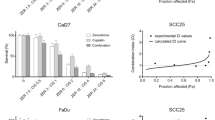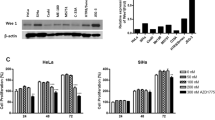Abstract Background and purpose
: The anticancer drug paclitaxel, a natural product from Taxus brevifolia, is a microtubule-stabilising agent, which has been shown to block different cells in the G2/M phase of the cell cycle and so modulate their radioresponsiveness. We investigated the radiosensitizing potential of paclitaxel in human head and neck cancer cells (ZMK-1), in cervical squamous cell carcinoma cells (CaSki) and in breast adenocarcinoma cells (MCF-7). Methods: ZMK-1 cells were incubated with paclitaxel for 3, 9, or 24 h before irradiation. ZMK-1-, CaSki- and MCF-7 cells were incubated with paclitaxel for 24 h after irradiation. The paclitaxel concentration (70 nM, 7 nM, 0.7 nM) was chosen to obtain equivalent toxicity at the different incubation times (3 h, 9 h, 24 h respectively). Radiation doses were from 0 to 8 Gy. Cell survival was measured by a standard clonogenic assay after a 9-day incubation. Flow cytometry was used to measure the capacity of paclitaxel to cause accumulation of cells in the G2/M phase of the cell cycle. Results: Paclitaxel alone was cytotoxic in a time- and concentration-dependent manner. Up to 36% of the ZMK-1 cells accumulated in G2/M after treatment for 24–36 h. If the cells were incubated with paclitaxel before irradiation the isoeffect enhancement ratios for ZMK-1 cells, determined at the 37% survival level, were 0.81, 1.48 and 1.15 for 3-h, 9-h, and 24-h pre-incubations respectively. For a paclitaxel incubation of 24 h after irradiation, the isoeffect enhancement ratios, determined at the 37% survival level, were 0.72, 0.76 and 1.2 for the ZMK-1, CaSki, and MCF-7 cells respectively. Conclusion: In the three cell lines no radiosensitizing effect of paclitaxel could be demonstrated unambiguously. The use of asynchronized cells or the support of cellular repair mechanisms while the cells are blocked in G2/M could partly explain the results.
Similar content being viewed by others
Author information
Authors and Affiliations
Additional information
Received: 24 June 1998 / Accepted: 2 October 1998
Rights and permissions
About this article
Cite this article
Pradier, O., Rave-Fränk, M., Schmidberger, H. et al. Effects of paclitaxel in combination with radiation on human head and neck cancer cells (ZMK-1), cervical squamous cell carcinoma (CaSki), and breast adenocarcinoma cells (MCF-7). J Cancer Res Clin Oncol 125, 20–27 (1999). https://doi.org/10.1007/s004320050237
Issue Date:
DOI: https://doi.org/10.1007/s004320050237




